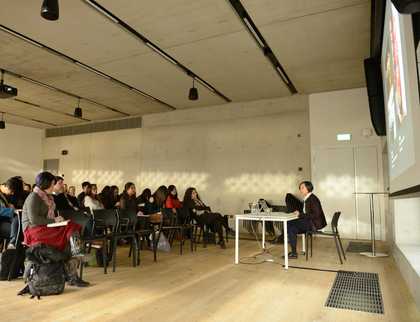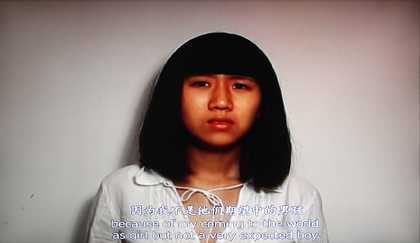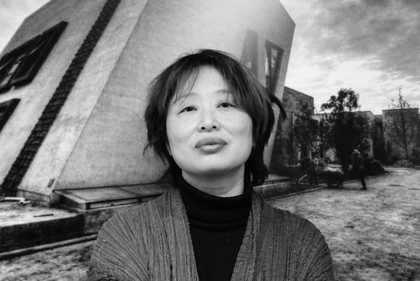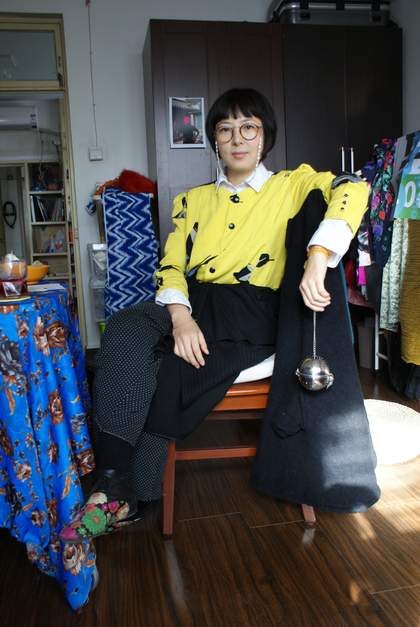
Gao Ling
Image courtesy of the artist
Monica Merlin: Let’s begin by talking about your latest project, The Big Mist.
Gao Ling: The Big Mist is a project about air pollution. In January this year, the PM 2.5 index [air quality index] in Beijing reached an alarming level. I was in the UK at the time and I saw photographs of the streets in Beijing – the city looked like a misty fairyland. I could not believe it. The images looked very beautiful, but they were also sad, since the fog is actually detrimental to people’s health. At that moment, I felt like I should do something.
So I initiated The Big Mist project on the internet and invited many people to participate. I asked them about their thoughts on air pollution, interventions they would like to make and any solution they would suggest. I tried to make it a fun process. A lot of people sent striking photographs of the serious condition of the pollution at the time. An artist friend of mine, who was on holiday in Beijing, joked that because the air was so dirty, they would need to take a shower as soon as they got back to their home in America.
Another photo shows a portrait of Mao in Tiananmen Square. They altered the image so that Mao’s hair looks as if it was blown by the turbulent air in a dust storm and you could not see his face clearly. They posted the photo on Weibo, the most popular Chinese microblog website, but left a blank circle where Mao’s head was instead of directly showing Mao’s portrait, probably in consideration of its sensitive nature. When I saw the photo, I really liked it, so I asked them whether they would like to join my project. They said of course and sent me a large version of the file.
There are some photographs from Holland as well. Some show people trying to blow away the pollution and some show a witch sending the pollution.

Gao Ling
Cave 2016
Part of The Big Mist Project 2013–ongoing
Image courtesy of the artist
Monica Merlin: Some of my friends jokingly call it ‘dry-cleaning’ when the wind blows the pollution away.
Gao Ling: That is really funny! You can invite your artist friends to join this project if they have ideas.
Monica Merlin: Did you make some of the photos yourself?
Gao Ling: Yes. For instance I took a photo while I was in London and there was heavy snow. The scene reminded me of what was happening in China. So for that photo, I thought that I should cover myself up completely and walk around the streets. I thought it would be visually more striking that way. But I regret that it was not taken in China. Once I came back to China, I got to make some other photos. Anyway, this project is still ongoing.
Monica Merlin: Do you think that you and other artists are particularly worried about the environment at the moment?
Gao Ling: Actually, I think everybody is worried. Yesterday, a friend of mine who works with pottery said that they were going to leave Beijing. They are from Beijing and have lived here for thirty years, but now they are going to move to the famous pottery town of Jingdezhen and work there. Even though they have a shop here in Beijing, they decided that working in Jingdezhen is more preferable, because Beijing is having more and more security issues and the air pollution shows no signs of improving. This was a major decision for them and air pollution played a big part in it. It is sad. Many other interesting people have also decided to leave, believing that Beijing is no longer suitable for living. Nothing can be done about it.
Monica Merlin: For yourself, do you think you will stay in Beijing or go back to the Netherlands?
Gao Ling: If the air pollution gets really bad, I may leave too. I lived in Shanghai for almost a decade before I moved here a couple of years ago. Even after I moved in, I did not spend a substantial amount of time here – things were a bit chaotic then without a studio. Later, I went to work in London for a period of time. It is only now when I have returned to Beijing that I can start concentrating on my work. When I decided to come back to China, I knew that I wanted to work in Beijing or Shanghai. It is a bit easier, because I have friends and a professional network in these two cities. Also, materials are cheaper than they are in the UK.
Monica Merlin: Could you talk about the different stages of your artistic career, starting at the beginning?
Gao Ling: When I started out, I was doing a lot more visual design, since I studied visual art. Later, I moved on to design icons and user interfaces for mobile apps. But after a while, I no longer enjoyed neither the job nor working in an office. I then bumped into some friends of one of my university teachers. These people were very important to me: they introduced me to the artist Wu Shanzhuan, who was an avant-garde artist in the 1985 New Wave. Since they had ideas but were not very good at designing, they asked me to help with their photography and design work.
I started helping with their work and then gradually came to do work for Wu and his wife, Inga Svala Thórsdóttir, who is an artist from Iceland. I worked for them for two or three years. During this time, I completely destroyed many ideas I had had in the past and absorbed new ideas from the couple. At the same time, I took part in an exhibition called Get It Louder, which was a global exhibition of Chinese artists. There I met many like-minded people who sought the clash of ideas and I started to produce work with them.
One work we produced is called Change a Room. At the time, I lived in a friend’s house in Beijing, while he lived with his girlfriend. Then, his girlfriend moved to Shanghai and stayed in my house. I suggested we make an artwork and leave something behind in our respective homes. We thought this would be great fun and we each changed the nature of the house we were staying in. From then on, a succession of invitations to exhibitions started to come in.
The work I exhibited at Get It Louder was Cold Wear, a bikini made of stainless steel. It started from a simple idea I had. In Shanghai, we would often go to the swimming pool in the summer. The Shanghai women were all wearing bikinis. We marvelled at how open they were and wondered what would happen if their bikinis fell off. I then got the idea to make a bikini out of metal, a very tough material and display it on the wall. The intended effect is just to make you smile – there is no other idea behind it. It is quite a light-hearted, entertaining work.
After this exhibition I began to get some attention from the media and some small groups of artists and I started to work on other exhibitions. I was chatting with a woman whom I met at an exhibition, Elaine Ho and we talked about how tricky it was for women to go to the public toilet. At parties and music festivals, men could get their business done very quickly, but women always had to wait in long queues. So while we were eating, we decided to make an artwork based on this idea. A woman seating nearby, who was from Switzerland, said that she knew a hand-held disposable device sold in Holland for this purpose and that she would bring one for us next time.
Elaine Ho and I then began to seriously develop ideas for the work Nv Quan (Women’s Fountain). She was in Beijing and I was in Shanghai, so we emailed each other back and forth. We discussed how we would approach the project, what we wanted to make and what materials to choose. In the end, we decided on porcelain and started working on a draft of the design. We started out making it by hand in Shanghai, exploring how the shape of the device could fit well with the shape of human groin and how to make sure that there urine would not leak out when one held the device to piss. We came up with all sorts of strange and weird shapes. We were really unprofessional then, but it was so much fun. After we made the first batch, we took them to Beijing to do a piece of performance art with a group of friends in the Summer Palace. There were men and women in our group and we all peed standing up using our prototypes. The first attempt was not so successful, as the shape of the prototypes did not fit the body well and the outward flow was very slow. So the women pissed onto their skirts – it was a complete mess – while the guys yelled out at us ‘we are done’ and ran off.
So, after this first attempt, we redesigned the device. The early design was oval and the outlet was very small, so it tended to leak. At the same time, our friends invented some new uses for the device. They found that the receptacles actually transmitted sound pretty well, so they used them as telephones in the performance at the Summer Palace. It was very entertaining.
Monica Merlin: Did anyone else see you when you were in the Summer Palace?
Gao Ling: Yes. We did the performance at around 6pm, hoping there would be fewer people. But there were still a lot of tourists around and the place we had chosen was not so good, so we went behind a bush and took some photographs.
Monica Merlin: Are all these devices, the Nv Quan, made out of porcelain? Did you use any other materials?
Gao Ling: No, they are all porcelain. They did not look very nice in the beginning and then we refined the shape. A school friend of mine introduced me to a potter, who had also been to art school. He added a green glaze to his pottery, making it look like jade. I was really impressed, so we ordered a batch to be made. But I think the potter did not really understand what we wanted to do, so about half of the first batch did not turn out right because the base was quite rough. Also, some broke because the packaging was not very good.
Monica Merlin: The title of the work, Nv Quan, literally means ‘female fountain’, but it is also homophonous with the word for ‘women’s rights’ (nüquan) and ‘feminism’ (nüquan zhuyi). What relationship do you see between the two?
Gao Ling: Elaine Ho and I were thinking about the posture of peeing and how it relates to one’s attitude towards gender difference. When you pee standing up, you are saying that you are equal to men. At the same time, you are making peeing into something beautiful and interesting. Unlike the early prototypes that leaked and left female users in a mess, the final products were really quite brilliant. It gives women an entirely different experience. Many women have told me that it is their dream to pee standing up and they really liked our devices.
Monica Merlin: Girls find out from a very young age that they have to queue for a long time and have to fuss over getting their clothing off to go to the toilet. If you have a handbag or something else, it is also a real pain.
Gao Ling: Actually, the Nv Quan can sometimes be a pain too. If you are wearing tight jeans it is hard to get it in properly, especially if the jeans do not open wide enough or are not flexible enough. Despite all these, it has saved women many troubles.
Monica Merlin: Is the work about gender equality and the differences in male and female bodies?
Gao Ling: I personally find that peeing in this position triggers a kind of primal strength in me. It feels really comfortable. I feel like a man.
Monica Merlin: How do you think this is related to feminism and gender equality?
Gao Ling: When we started, we did not think too much about these issues. We just wanted to do away with the long waiting time for women, not only because we do not like waiting, but also because it is not healthy to hold it in. Also, it was simply a lot of fun to work on this project. Later, people came to read feminism and the demand for gender equality into the work. This layer of meaning gradually emerged over time, especially as we realised the title itself has very strong link to feminism.
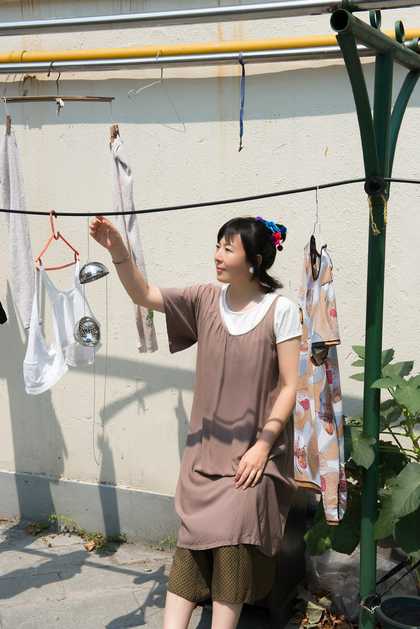
Gao Ling
‘Hey! TTTTouch Me!’ 2010
Images courtesy of the artist
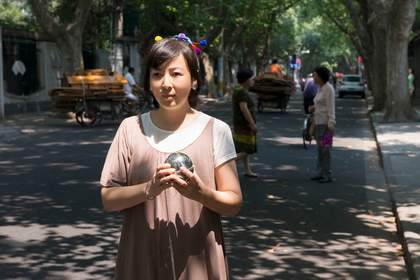
Gao Ling
‘Hey! TTTTouch Me!’ 2010
Images courtesy of the artist
Monica Merlin: You have another performance piece called ‘Hey! TTTTouch Me!’. Are the metal bras featured in this performance connected to the metal bikini in Cold Wear?
Gao Ling: The thing they have in common is that both try to make you smile. But I actually do not want to make a connection between them, because I am still growing and developing. I discovered that it is more interesting to enter into a relationship with your environment. The ‘bras’ in ‘Hey! TTTTouch Me!’ are actually tea infusers that I opened up and altered slightly. They come in different sizes: large, medium, small and extra small. Currently the tea infuser bras are in San Francisco. They were shown in the WOMEN exhibition there last year and will go to Miami this year. So I only have one left with me here.
It was a lot of fun to turn a readymade kitchen implement, something that women ‘should’ be using, into a piece of clothing you wear in the underground, as an act of humour or anti-harassment. I had a personal experience of this. I used to go to work by underground and I would often get pushed and shoved onto the train. I felt like my body did not belong to me anymore and that once I got on the train, people around me could just do whatever they liked to me. I thought it was so strange that people in the city have to live this way. I was really unhappy about it.
Monica Merlin: Do you think this discomfort is something that women specifically have to deal with on public transportation?
Gao Ling: I think so. Of course, men may also feel uncomfortable, but most women simply are not interested in touching men. On the other hand, women often find parts of their bodies being ‘bumped into’ on public transportation. Some men do this on purpose; even if they did not do it on purpose, the women still feel awkward. I wanted to make this strange sense of awkwardness disappear.
The performance was done in Shanghai. I asked several friends to dress as office workers and join me in performing on the underground. The Chinese micro-blogging site Weibo was just getting popular at that time, so lots of people took photos of us and posted them on Weibo. The next year, we did another performance.
The background for this second performance is that the official Weibo account for Line 2 of the Shanghai subway had posted a picture of a woman photographed from behind. She was wearing a thin, semi-transparent dress and you could see her underwear through it. The employee who posted it said, ‘It would be strange if a woman dressed like this was not harassed. There are many perverts on the subway and you cannot prevent all of them from taking action. Ladies, please have some self-respect.’ The phrase ‘have some self-respect’ really angered a lot of people, since it was aimed at all women. Lots of people asked why the responsibility was being pushed onto the women and why no one was commenting on male behaviour.
The curator of the WOMEN exhibition I participated was talking with the artists featured in the first exhibition and some volunteers about how the actions of the subway company had damaged the situation for women in a way that was just not acceptable. So they decided to do an anti-harassment performance and because they remembered I had made ‘Hey! TTTTouch Me!’, they invited me to take part. We only decided on the slogan, ‘I can be sexy, but you cannot harass me’, at a meeting on the morning of the performance.
Monica Merlin: How long were you on the subway for?
Gao Ling: We were there for about half an hour. Nobody knew what we were doing. In the first performance, we thought everybody would be staring at us in our strange get-up, but Shanghai is actually a very open city and people did not really pay much attention. They probably thought we were just taking photos.
However, when we started the second performance at People’s Square, the busiest station in the city, we got drew a larger crowd since we picked a weekend evening. A crowd soon gathered around us to take pictures and ask questions.
Monica Merlin: Perhaps the second performance gained more attention than the first?
Gao Ling: Yes. I think the clothing was more noticeable the second time and because the performers carried slogans, people were more likely to stop and ask what was going on. I was taking photos, so I explained the performance to people. Many people began to post our photos on Weibo, including our own group of volunteers whose organiser was a woman called Xiang Qi. They had friends in the media, so they forwarded the photos to many women’s groups and social media as well. So the whole thing snowballed really fast. There were so many people stopping to watch our performance that it caused a minor disturbance. The subway security guards turned up and were preparing to intervene. The performers saw that the situation was not looking good, so they shrewdly took off their costumes, picked up their things and went off for a meal.
Monica Merlin: Did the police turn up?
Gao Ling: Not at that point, since after all we did not do harm to anyone. It was just a performance, just a protest. But it sparked a torrent of discussion and heated debate among scholars, intellectuals and the general public on the internet in the following days. Some people called us foolish, wearing weird things to do a performance like this on the underground.
Monica Merlin: Did you reply to them?
Gao Ling: I probably did, but I didn’t want to say too much, since the more I said the more out of line they would get. I just replied by saying that we were doing what we thought we should do. I did not want to go too deep.
Monica Merlin: What results would a performance like this have in Beijing?
Gao Ling: I haven’t tried it in Beijing. I thought about it for a while, but I wouldn’t be able to since the situation in Beijing is too sensitive. It would be really exciting to do it in Beijing though.
Later, this performance was incorporated into the WOMEN exhibition and went to San Francisco for a separate exhibition. It triggered discussions within American scholars and art critics about what was happening in China. They showed a great deal of interest, even more than people in Shanghai. They also think in a different way. In China, people go home as soon as a meeting finishes. In San Francisco, however, they discuss things in great depth, collect materials and make an effort to record the event. They have a video of the entire performance in Los Angeles.
There was another performance under the Nv Quan title, which also connected to gender equality and which took place just after the first WOMEN exhibition in Shanghai. There is a type of food in China known as ‘virgin boy piss eggs’, which originates from Jinhua in Zhejiang Province. Every year in spring, they collect the urine of boys under the age of ten and boil eggs in it. It is said that eating these eggs in a specific season is very nourishing, so the urine of young boys becomes very pricy over this period. But we wondered why it should be the urine of young boys and not of young girls. It is another fun aspect of gender inequality. We collected the urine of young girls and held a live performance during which we boiled quail eggs in the urine and offered them to people to taste. A lot of people wanted to eat them. I did not dare eat them in the beginning though: they stank! There was a strong smell all around the place where we put up the performance. All the friends we invited could not understand why we’d asked them over to eat this thing. But I think that it was a very meaningful performance. We also provided an introduction to the history of ‘virgin boy piss eggs’ and a recipe that told you how to make them.
Monica Merlin: I see that you collaborated with a male artist on this work.
Gao Ling: Yes. Elaine Ho, whom I regularly collaborate with in a duo called LING & COMMA, was teaching in Wuhan and could not make it. So I found another collaborator instead.
I also worked on a project as a visiting artist in Berlin, at a space called Program. That project was about yawning, since I had started to notice how contagious yawns are. If you see someone yawning, or you sit next to someone who is yawning, or even just look at a photo of someone yawning, you really want to yawn yourself. I saw on the internet that an artist had made oil paintings of yawns from photos, but I wanted to do something different. I invited a lot of people to Program and got them to meditate together.
Monica Merlin: I want to yawn too now!
Gao Ling: Yawn away! Even listening to someone talking about yawns makes you want to yawn. It is a really interesting phenomenon. Anyway, I showed the people I invited a TV test pattern combined with some white noise. We had these test patterns when we were young, telling you that the shows were over for the evening and it was time to go to bed. I thought that this might push them in a certain direction while they were meditating and relaxing. In the beginning, they felt a bit bored and after a while some of them started to yawn, which caught on and soon everyone was yawning. I told them in advance that it was a project about yawning, so they were already aware of the topic. Maybe some of them yawned on purpose. But it spread to everyone else all the same.
I also asked people to sit still so that I could photograph their face yawning. Some people only yawned after a long time and some of the photographs were stills from a video – I filmed them for ten to twenty minutes. When I had all the photos, I made a set of playing cards with them. This set of playing cards differs from other ones in that you would start yawning while you play! I call them ‘yawning cards’. The idea is that you forget the rules of the game; the rules become whoever yawns loses.
Monica Merlin: What other exhibitions have you taken part in recently?
Gao Ling: I was also featured in an exhibition last year called Night-wandering 1: Hutong. The title refers to the idea of compulsively wandering round the hutong, the traditional alleyways of Northern China. The exhibition’s theme is a rather pathological symptom, in which you feel like you have to get things done. I participated in the exhibition, but since I was in London at the time, my friends helped me produce a text-based work called More Than ‘Forget About It’ (Suan le). The phrase in Chinese has a range of meanings, including ‘forget about it’, ‘do not worry about it’ and an exclamation expressing exasperation or resignation. It has always resonated with me. When I was still in Shanghai, all my friends would urge me to move to Beijing, saying that the art scene was better there. I’d often use the phrase ‘suan le’, saying to myself, ‘Enough! I’ll sell everything and move to Beijing!’ I realised that the phrase could be used to describe a whole range of different situations. For example, say that I am going to buy something now, but later I think ‘Actually, forget about it. I do not need it.’ I realised that all these ‘forgotten-about’ things, things that I gave up, had perhaps played a part in creating who I am today. This is also a topic which I am interested in. That is why I created this installation. Because the exhibition was held at night, I made gobos and fitted them to two powerful torches so that the phrase ‘forget about it’ was projected all over the place.
It was tricky to come up with an English title for the work. I first thought about translating it as Don’t Worry About It, but then I thought that it was not quite right. It has different meanings in different contexts, so the work is a bit lost on people who do not speak Chinese.
Monica Merlin: I think ‘whatever’ could work quite well as a translated title.
Gao Ling: Yes, that is a bit more colloquial. My English was not so good, so I asked other people to translate it for me. In the end we just thought, ‘Forget about it, it is too complicated!’ I’d also like to make bags with the phrase printed on them. I wanted to hold an exhibition at my home before I left Shanghai featuring works related to the phrase. But in the end, I decided to drop it and just thought ‘forget about it!’ It is such an interesting phrase you use in so many life situations.
Another exhibition I did this year, Night-wandering 2: Market, was held in a large fruit and vegetable market in Beijing. They asked me to do an installation, so I went to have a look at the market. The stallholders, especially those selling meat, set up cheap electric fans from which they hang strings or plastic bags, a device that rotates and chases off flies. I made an altered version using a garish coloured fan and installed it in the stalls. They did not know what on earth it was, but were happy to have it in their stall once I told them that it would keep the flies away. One stall was selling Beijing pancakes, which are made on a large rotating griddle. The connection between the two spinning machines, the rotating fan and the smoking griddle is really interesting to see. I mostly like art that can make you smile. We made a video of it the installation – I called it Crazy Busy.
Alone, Lonely and Cold is another fun work. The title comes from a phrase in one of Stephen Chow’s films called Kung Fu Hustle. His films are always very funny and are characterised by an absurdist humour. Two really interesting phrases that come out of King Fu Hustle are ‘alone, lonely, cold’ and ‘envious, jealous, hateful.’ The combination of words describes these feelings perfectly. When you are ‘alone’, you do not know what to do with yourself. Then imagine being ‘lonely’ on top of that and ‘cold’ on top of that! It feels like being drenched in a whole bucket of cold water. His films are generally entertaining and funny, with some sadness at the end. It makes you pause for a moment. The other phrase, ‘envious, jealous, hateful,’ is also a great description of emotion. I’d feel ‘envious, jealous and hateful’ towards you if you had the newest iPhone! You cannot describe these emotions any better.
Another exhibition you may be interested in is WHO’s GOT IT. It featured works about women and their fantasies. The exhibition took place in a politically sensitive time and venue – it was just before the closing of the Shanghai World Expo. There was also a politically sensitive phrase in one of the works due to be shown. So when we submitted the exhibition for approval the censors decided that it was too politically sensitive and ‘inelegant’ to show to the public. The ‘inelegant’ content was Nüquan – they thought it was awful to show women pee standing up.
Monica Merlin: Where was this? What happened in the end?
Gao Ling: At a place called Down-stream Garage. It is an underground theatre centre that had just opened an exhibition space. The exhibition was cancelled on the day we sent out invites. We were really angry and unhappy at the decision. In the end, we decided that since we could not exhibit, we would show an empty space. On the opening day, lots of people came because there was a play going on. We put a humidifier in the empty space and filled it with urine, since Nv Quan was related to urine too. The whole space stank of piss! By doing this, we moved the exhibit into the air and changed it into a different performance, one that was a bit of a piss-take.
The whole space was completely empty, with just the humidifier in the corner. All the other works had been hidden away. When the people from the Culture, Radio, Film, & TV Administration came to check, they left when they saw there was nothing in the space – they did not figure out what was going on. We had to have our fun by playing with things they could not find out about. It was another way of protesting.
A couple of weeks later, the censors changed their minds and gave us permission to hold the exhibition after all. A lot of government employees came over to check it and I was the only artist there. There were about ten of them and they brought me into their meeting to ask me about the exhibition. A man asked why performance art had to be about stripping naked and running around outside. I said that if that was what he thought performance art was, he hadn’t seen enough of it. He then asked what kind of performances we would do. They might have been tapping my phone calls, as they already seemed to know what we were planning. I told him that we were not going to do much and that the exhibition was about showcasing a new lifestyle. He seemed relatively happy with my answer. He said that he might have no problem with our works, but his parents and grandparents definitely could not accept them. I said that we could not possibly make works that would satisfy everyone.
The other inspectors were all fine. One corrected an English translation for us. After they had finished asking their questions, they decided that the exhibition did not contain anything too radical or too angry. Then they looked through the details of all the works. One artwork was a map of the Shanghai underground with all the toilets highlighted. It actually took a lot of hard work! I showed this to them, saying that this was actually a charitable project, since it was a good thing that nobody else had done. They thought that this was great and eventually allowed the exhibition to go ahead. The exhibition had a lot more stories behind it thanks to them! It was a lot of fun.
Monica Merlin: Did you get to exhibit the works you originally wanted to exhibit in the end, or did you have to alter them?
Gao Ling: We added in another performance, which you could not call particularly radical. It took place in the toilets and involved painting Chinese ink landscape paintings with urine.
Monica Merlin: Are there lots of toilets in the Shanghai underground?
Gao Ling: Yes, there are quite a few. But the problem with Shanghai is that there are hardly any outside the underground. It is not like Beijing, where there are toilets scattered everywhere throughout the hutong. It is really convenient. In Shanghai, it is really hard to find a public toilet. You have to go to a hotel, a café, or a McDonald’s, but sometimes they do not let non-paying customers use their toilets. It is quite unfeeling of them. So sometimes I end up in great pain from holding it in. That is why I really wanted to make Nv Quan: if you won’t let me use the toilet, I will just have to pee standing up instead!
Monica Merlin: Do you have new performances or artworks in the pipeline, or are you taking things easy for a bit?
Gao Ling: Actually, Elaine Ho has created a space in Beijing called HomeShop. They rent out desk space and also have an activity space for projects or food activities. It has been going for three years, but will probably close at the end of December, because the landlord suddenly tripled the rent from 10,000 RMB (about £1,000) to 30,000 RMB (over £3,000). We will hold an exhibition there before it closes. The exhibition take the form of a market. It is based on a concept called WaoBao, a system used by HomeShop and named after the Chinese eBay-style site Taobao. You take in the things you do not want and, once they have been checked, exchange them for a token. You can then exchange the tokens for things sold by HomeShop. It will be a place for exchanging second-hand goods, which is nothing new at HomeShop. However, this time we will add some performance art or artworks into the mix and have some fun with it. My initial idea is to exchange words and phrases that I do not want to use anymore with other people. They might be words that were once briefly popular, or internet words; words that are not of any use to me anymore and so can be exchanged for other things. I’m still thinking about it.
Monica Merlin interviewed Gao Ling in her Beijing studio-home on 15 November 2013.

